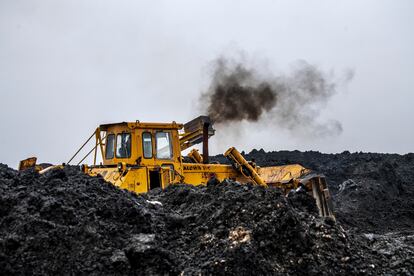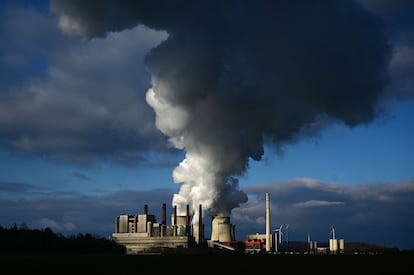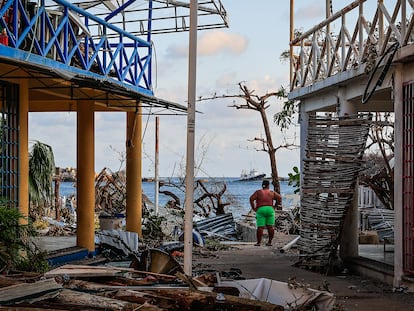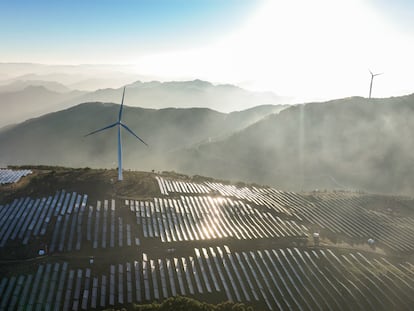2023: Another year of records and devastation in the climate crisis
‘We are living through climate collapse in real time,’ said U.N. Secretary-General António Gutérres in a message released to coincide with the presentation of the WMO’s interim report on the state of the climate ahead of COP28


The United Nations Climate Change Conference, COP28, opened Thursday in Dubai by sounding an alarm that, unfortunately, does not appear to be new. It has been ringing for a long time without the source of the problem being addressed: greenhouse gas emissions, the main source of which is to be found in the fossil fuels that power the global economy. As the concentration of these gases in the atmosphere reaches new record levels, it is almost certain that 2023 will be the warmest year on record since at least 1850, when the series of direct measurements of temperature began. That year is also taken as the reference point for the beginning of the current climate crisis as it was the moment in which humans began to use coal, oil, and gas on a massive scale to drive the Industrial Revolution.
“We are living through climate collapse in real time,” said U.N. Secretary-General António Gutérres in a message released to coincide with the presentation of the World Meteorological Organization (WMO)’s interim report on the state of the climate in 2023. “This year has seen communities around the world pounded by fires, floods, and searing temperature — and the impact is devastating.” The WMO’s annual analysis is the starting signal for the U.N. climate summit, which began Thursday in the United Arab Emirates, marked by the uncertainties generated by an oil-producing country leading the negotiations.
Although COP28 opens Thursday, it will be during Friday and Saturday that the summit of leaders will be held, in which more than 160 world leaders are expected to participate. Around 100,000 people have been accredited to participate at the summit, making it the largest so far. However, the presidents of China and the United States will not be present. In the case of Xi Jinping, it has become customary for him not to attend COP summits in recent years. This will be the first COP summit Biden has failed to attend as president and is due to agenda issues, according to his administration, although authorizations for new hydrocarbon prospecting that have been endorsed by the White House have generated unease among many activists. This, however, does not mean that Beijing and Washington will not play an active and decisive role in Dubai once the leaders depart. That is when the negotiators will continue their work as John Kerry, Biden’s special envoy for climate change and a veteran of these conferences, noted on Wednesday. It will be at that point that the real negotiations, which will focus largely on fossil fuels, will get underway.
During the opening of the summit Thursday, delegates from the nearly 200 participating nations ratified the appointment of the United Arab Emirates Minister of Industry and Advanced Technology, Sultan Ahmed al-Jaber, as COP28 president. There has been controversy since it was announced at the beginning of the year that he would occupy the position, as he is also the CEO of the Abu Dhabi National Oil Company. And there is some uncertainty about how he will lead the talks at a conference that is due to take stock of the progress nations have made since the Paris Agreement was signed in 2015. But, perhaps, the most important thing is not what has been done so far (which is not enough), but what must be done from this moment on, which involves multiplying renewable power capacity.
As important as the installation of clean energy is the move away from fossil fuels. “Record global heat should send shivers down the spines of world leaders,” Gutérres said Thursday in a video message for the presentation of the WMO report. “And it should trigger them to act.” The United Nations secretary general recalled that there is a road map to limit the global temperature rise and that this includes nations committing to “triple renewables, double energy efficiency… and phase out fossil fuels,” with a clear timetable.
In his first official speech as president of COP28, al-Jaber acknowledged that part of the discussions will focus on the references to renewables and fossil fuels. But he went on to defend the commitment of oil and gas companies to take on net-zero emissions targets. These commitments, as U.N. reports and other prestigious institutions have repeatedly warned, are of little use if the plans of the companies and producing countries continue to include increasing oil, gas, and coal extraction in the coming decades.

Natural disasters
While delegates negotiate, a climate crisis that has led to record lows in Antarctic sea ice this year will continue. Sea surface temperatures and sea level rise are also at record levels, and 2023 is on track to be the warmest year on record.
These are all indications of the growing climate crisis but, perhaps, the most immediate and most damaging elements are extreme weather events, which are already increasing in intensity and frequency due to global warming. The WMO lists “major floods and flash floods, tropical cyclones, and extreme heat and drought events, with associated wildfires,” among these. The list drawn up in its annual report is large and includes, for example, the devastating floods caused by extreme precipitation due to Mediterranean Storm Daniel in Greece, Bulgaria, Turkey, and Libya, where thousands of people were killed in Derna.
Extreme heat in many parts of the world was another of the events highlighted in the report. “Some of the most significant episodes occurred in southern Europe and northern Africa, especially in the second half of July, when the heat was intense and exceptionally persistent,” says the WMO. In Canada, the wildfire season “far exceeded all previous ones,” the organization noted. “The total area burned nationally through October 15 was 18.5 million hectares, more than six times the decadal average (2013-2022).” In Hawaii at least 99 fatalities were reported in what was the deadliest fire in the last 100 years in the United States.
In the Horn of Africa, the 2023 analysis highlights that “five consecutive drought seasons were followed by flooding, which led to even more displacement.” And in many parts of Latin America, drought intensified: in northern Argentina and Uruguay, cumulative rainfall between January and August was 20% to 50% below average.
Sign up for our weekly newsletter to get more English-language news coverage from EL PAÍS USA Edition
Tu suscripción se está usando en otro dispositivo
¿Quieres añadir otro usuario a tu suscripción?
Si continúas leyendo en este dispositivo, no se podrá leer en el otro.
FlechaTu suscripción se está usando en otro dispositivo y solo puedes acceder a EL PAÍS desde un dispositivo a la vez.
Si quieres compartir tu cuenta, cambia tu suscripción a la modalidad Premium, así podrás añadir otro usuario. Cada uno accederá con su propia cuenta de email, lo que os permitirá personalizar vuestra experiencia en EL PAÍS.
¿Tienes una suscripción de empresa? Accede aquí para contratar más cuentas.
En el caso de no saber quién está usando tu cuenta, te recomendamos cambiar tu contraseña aquí.
Si decides continuar compartiendo tu cuenta, este mensaje se mostrará en tu dispositivo y en el de la otra persona que está usando tu cuenta de forma indefinida, afectando a tu experiencia de lectura. Puedes consultar aquí los términos y condiciones de la suscripción digital.
More information

Do countries actually have the money to fight climate change?
Archived In
Últimas noticias
The metaverse, four years later: Is it finished or just at a standstill?
$3,000 and a plane ticket: The United States increases incentives for migrants to self-deport before the end of the year
Charles Dubouloz, mountaineering star, retires at 36 with a farewell tour inspired by Walter Bonatti
From the White House to diplomatic gifts: Lego wins over adult fans, brick by brick
Most viewed
- The low-cost creative revolution: How technology is making art accessible to everyone
- Christian Louboutin: ‘Young people don’t want to be like their parents. And if their parents wear sneakers, they’re going to look for something else’
- All the effects of gentrification in one corner of Mexico’s Colonia Roma
- Christmas loses its festive spirit: ICE fears cast shadow over religious celebrations
- Liset Menéndez de la Prida, neuroscientist: ‘It’s not normal to constantly seek pleasure; it’s important to be bored, to be calm’









































